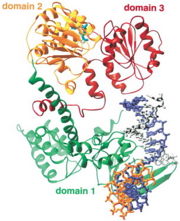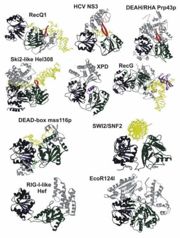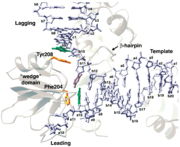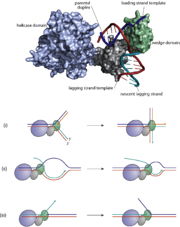RecG protein
From Proteopedia
RecGThe RecG protein of Escherichia coli is a Superfamily 2 (SF2) branched-DNA-specific helicase which promotes rescue of damaged replication forks by catalyzing their unwinding and conversion to Holliday junctions. A single RecG monomer unwinds two DNA duplexes; the leading strand duplex and the lagging strand duplex and then re-anneal the parental and the newly synthetized strands. This mechanism of repair is ATP-dependent and does not require DNA double strand break. RecG works synergistically with the RuvABC repair system[1],[2].
Helicases are a ubiquitous group of enzymes that use the energy of nucleoside triphosphate (NTP) hydrolysis to catalyze the separation of double-stranded nucleic acids (dsNA). Therefore, helicases are involved in essentially every step in DNA and RNA metabolism, including replication, DNA repair, recombination, transcription, translation, chromatin rearrangement, ribosome synthesis, RNA maturation and splicing, nuclear export, Holliday junction movement, and displacement of proteins from DNA and RNA.
Superfamily 2 is the largest and most diverse of the helicase superfamilies. It has been further divided into families including RecQ-like, RecG-like, Rad3/XPD, Ski2-like, type I restriction enzyme, RIG-I-like, NS3/NPH-II, DEAH/RHA, DEAD-box, and Swi/Snf families based on sequence homology. Since SF2 helicases function in diverse parts of nucleic acid metabolism, defects are associated with a variety of diseases including predisposition to cancer, premature aging, immunodeficiency, and mental retardation[3].
STRUCTURE
PDB access: 1gm5
Crystal structure of Thermatoga maritima RecG protein bound to three-way DNA junction has been determined at a 3.24 Å resolution. The protein complexed with ADP and synthetic DNA substrate that mimics a stalled replication fork in which the leading strand synthesis is behind that of the lagging strand. The structure of RecG revealed a monomeric conformational arrangement that can be subdivided into three domains: Domain 1 (residues 1-350), Domain 2 (residues 351–549), and Domain 3 (residues 550–780). Domain 1 is at the N terminus and is about a half of the protein. It contains a long α helix in the center of the domain. This helix provides a rigid structural foundation upon which the rest of the domain is folded. There are two common structural motifs in Domain 1. Residues 21–99 form an antiparallel four helix bundle, preceded by an additional α helix. The second one is a greek key motif (residues 154–252) that is conserved in all RecG sequences. This motif is the binding site of the protein to the DNA. The C-terminal domains: Domains 2 and 3 contain the characteristic motifs that identify RecG as an SF2 helicase. This part of the protein is structurally homologous with other SF2 helicases. ATP binds in the cleft between these domains and induces change in their relative orientation. Domain’s 3 last 50 residues are forming a hook that wraps around the extended α helix of the Domain 1. This interaction provides a link between Domains 1 and 3 that is likely to be affected by nucleotide binding[1].
INTERACTIONS WITH DNADomain 1 of RecG contacts with DNA at the junction itself, indicating the specificity of the interaction with stalled replication forks. The junction is hold by the greek key motif on one side and an extended β hairpin (residues 259–266) on another. The template strands interact with the protein grooves that are too small to accommodate DNA duplex, resulting in simultaneous split of the leading and the lagging strands. The breaking of the leading strand and the lagging strand duplexes is stabilized by the aromatic ring of Phe 204 and Tyr 208 of the protein, respectively. This mimicks base stacking of a duplex DNA structure. One of the DNA bases doesn’t contact with RecG, serving as a transient state to facilitate flipping between the duplexes during junction migration. Additionally, the phosphodiester backbones of the duplex arms of the junction are interacting with Domain 1 and 3 of RecG. The interaction allows the formation of either a B-form (DNA) or an A-form duplex (DNA/RNA), what explains why RecG can unwind Holliday junctions (DNA) as well as R-loops (RNA)[1].
RecG is an enzyme with helicase, translocase and ATPase activity. It binds to a stalled replication fork and converts it into a holliday junction, which can be resolved later by RuvC. RecG binds initially to the junction with the arms of the fork located at domain 1 of the protein. The orphan base pairs are stabilized by aromatic interactions with the protein. In order to unwind both arms simultaneously, the protein drags the junction across the wedge domain (residues 154–252). Due to steric interference only the template strands on the leading and lagging arms would be able to pass through the grooves on either side of the wedge domain. Therefore, the newly synthetized strands are stripped off the template, but their proximity allows association of these complementary strands to form a four-way junction. This translocation is driven by a repetitive opening and closing of the cleft between Domains 2 and 3 as ATP binds and hydrolyzes, allowing the protein alternately to bind and release the template duplex region, thereby walking along the DNA[1].
RELEVANCE
The RecG of Escherichia coli is needed for normal levels of recombination and for repair of damaged DNA. RecG homologues are found in most bacterial species[4]. Strains carrying mutations in this gene show reduced recombination in conjugational crosses and increased sensitivity to UV, mitomycin C and ionizing radiation[5],[6],[7]. The mutants' phenotype is very mild and the dramatic increase in sensitivity to DNA damaging agents observed when recG null alleles are combined with ruv mutations inactivating the RuvABC Holliday junction resolvase[8]. These findings suggest that RecG and RuvABC are part of two overlapping pathways to overcome damage to DNA via a recombination mechanism. Despite the important role of RecG in bacteria, there are no known homologs in other organisms, at least at the sequence level. However, phage T4 protein UvsW can complement a recG defect in E. coli, showing that it is a functional homolog of RecG[9]. The conservation of function rather than sequence raises the possibility that there may be proteins with RecG-like functions in other organisms. Indeed, it has been suggested that a number of helicases (e.g., Werner's, BLM, and Sgs1) may play a role in the recovery of stalled replication forks in eukaryotes[10].
3D Structures of RecG
Updated on 05-February-2019
1gm5 - RecG + DNA - Escherichia coli
- ↑ 1.0 1.1 1.2 1.3 Singleton, M. R., Scaife, S. & Wigley, D. B. Structural analysis of DNA replication fork reversal by RecG. Cell 107, 79–89 (2001)
- ↑ Rudolph, C. J., Upton, A. L., Briggs, G. S. & Lloyd, R. G. Is RecG a general guardian of the bacterial genome? DNA Repair 9, 210–223 (2010)
- ↑ Byrd, A. K., & Raney, K. D. (2012). Superfamily 2 helicases. Frontiers in Bioscience (Landmark Edition), 17, 2070–2088
- ↑ Sharples, G. J., Ingleston, S. M. & Lloyd, R. G. Holliday junction processing in bacteria: Insights from the evolutionary conservation of RuvABC, RecG, and RusA. Journal of Bacteriology 181, 5543–5550 (1999)
- ↑ Storm, P. K., Hoekstra, W. P. M., De Haan, P. G. & Verhoef, C. Genetic recombination in Escherichia coli. IV. Isolation and characterization of recombinaion-deficient mutants of Escherichia coli K12. Mutation Research - Fundamental and Molecular Mechanisms of Mutagenesis13,9–17 (1971)
- ↑ Lloyd, R. G. & Buckman, C. Genetic analysis of the recG locus of Escherichia coli K-12 and of its role in recombination and DNA repair. Journal of bacteriology173,1004–1011 (1991)
- ↑ Kalman, M., Murphy, H. & Cashel, M. The nucleotide sequence of recG, the distal spo operon gene in Escherichia coli K-12. Gene110,95–99 (1992)
- ↑ Pang, Q., Hays, J. B. & Rajagopal, I. Two cDNAs from the plant Arabidopsis thaliana that partially restore recombination proficiency and DNA-damage resistance to E.coli mutants lacking recombination-intermediate-resolution activities. Nucleic Acids Research21,1647–1653 (1993)
- ↑ Dudas, K. C. & Kreuzer, K. N. UvsW protein regulates bacteriophage T4 origin-dependent replication by unwinding R-loops. Molecular and Cellular Biology21,2706–2715 (2001)
- ↑ Frei, C. & Gasser, S. M. RecQ-like helicases: the DNA replication checkpoint connection. Journal of cell science113 ( Pt 1,2641–2646 (2000)




